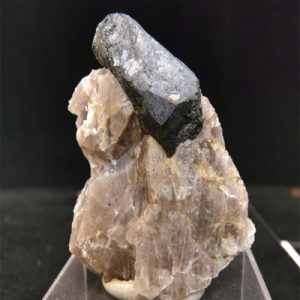Strüverite
Strüverite is an Iron (Fe), Niobium (Nb) and Tantalum (Ta) bearing variety of Rutile (TiO2) that was named to honor Giovanni Strüver (1842-1915), Professor of Mineralogy, University of Rome, Italy. Strüverite was discredited by the International Mineralogical Association (IMA) in 2006 and determined to be a variety of Rutile and not a distinct mineral species. It was suggested by B. H. Flinter of the Geological Survey Department, Federation of Malaya in 1939 that a proper name for this mineral should be Niobian-Rutile or Tantalian-Rutile due to its Niobium and Tantalum content. Strüverite is closely related to Ilmenorutile. Ilmenorutile has a much high Niobium and much lower Tantalum content than Strüverite. Chemically the two are very similar. However, the specific gravity of Strüverite is around 5.2 compared to 4.3 – 4.6 for Ilmenorutile. Strüverite is typically opaque black with adamantine to resinous luster.
Locations: from Craveggia, Val Vigezzo, Piedmont, Italy. At Vêñá, near Rozná, and Písek, Czech Republic. In the Etta mine, near Keystone, Pennington County, South Dakota, USA. At Tongafeno, Fefana, Mananjary, Ampangabé, and elsewhere in Madagascar. From near Salak North, Kuala Kangsar, Perak, Malaya. At Globe Hill, Western Australia. Other localities are reported, either undefined, or the material requiring modern confirmation.
| Chemical Formula: | (Ti,Ta,Fe2+)O2 |
| Titanium Tantalum Iron Oxide | |
| Molecular Weight: | 117.38 gm |
| Composition: | Tantalum | 30.83 % | Ta | 37.65 % | Ta2O5 |
| Titanium | 24.48 % | Ti | 40.83 % | TiO2 | |
| Niobium | 7.92 % | Nb | 11.32 % | Nb2O5 | |
| Iron | 9.52 % | Fe | 12.24 % | FeO | |
| Oxygen | 27.26 % | O | |||
| 100.00 % | 102.04 % | = TOTAL OXIDE |
| Crystallography: | Tetragonal – Ditetragonal Dipyramidal |
| Crystal Habit: | As Dipyramidal, prismatic crystals, to several cm, with striated prism faces. |
| Twinning: | Common on {101} |
| Cleavage: | Distinct on {110} |
| Fracture: | Conchoidal |
| Tenacity: | Brittle |
| Moh’s Hardness: | 6.0 – 6.5; VHN = 911 – 998 |
| Density: | 4.20 – 5.80 (g/cm3) |
| Luminescence: | None |
| Radioactivity: | Not Radioactive |
| Color: | Black; red or reddish brown in transmitted light; light gray in reflected light |
| Transparency: | Opaque; translucent through thin edges |
| Luster: | Adamantine, Resinous |
| Bereflectance: | Weak; R1 – R2: n.d. |
| Dispersion: | Strong |
| Pleochroism: | Strong; E = brown; O = dark bluish green or greenish blue |
| Anisotropism: | Strong |


